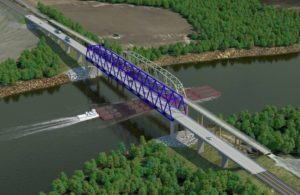 PADUCAH, Ky. (July 21, 2020) — Construction of the New U.S. 60 Cumberland River Bridge at Smithland, in Livingston County, is expected to ramp up substantially after August 1, 2020.
PADUCAH, Ky. (July 21, 2020) — Construction of the New U.S. 60 Cumberland River Bridge at Smithland, in Livingston County, is expected to ramp up substantially after August 1, 2020.
Jim Smith Contracting of Grand Rivers is the prime contractor for a $63.6 million project to erect a new 1,912 ft. structure immediately downstream from the 89-year old bridge it is replacing. The contractor and Kentucky Transportation Cabinet engineers have established a work schedule for the project.
The contractor has begun maintenance work on the existing bridge. KYTC District 1 Chief Engineer Kyle Poat says pre-construction activities such as placement of work zone signage, work on access roads, as well as an equipment assembly and supply storage yard, could start this week.
“Work on the existing bridge is aimed at getting it in optimum condition for the 3-year construction timeline for the new bridge,” Poat said. “While there will be some pre-construction work at the site of the new bridge over the next two weeks, the first real sign of construction on the new bridge will start with the clearing of trees and brush around August 1.”
During a pre-construction conference, Jim Smith Contracting provided an outline of the construction schedule:
July 2020
Pier and bearing repairs on the existing bridge, with few traffic disruptions
Pre-Construction of access roads, laydown yard, equipment deliveries
August 2020
Tree and brush removal with initial excavations to prepare for pier construction
Embankment prep for north approach
Excavations to prepare for south approach
September 2020
Start on Pier 1 & 2 construction & abutment
Start piers 5-9
October 2020
Shafts for Pier 3
Utility work – water and sewer
November 2020
Steel fabrication for approach spans
Approach 1 & 2 beams
Concrete on initial approach spans
January 2021
Infrastructure for truss assembly site
March-June 2021
Pier 3 footing, columns, web wall, cap
South abutment
Shafts at Pier 4
July-October 2021
Beams on spans 10, 9, 8, 7, 6, 3
Cofferdam for Pier 4
Concrete north approach spans
Structural steel deliveries
Begin assembly of main truss
Pier 4 footing, columns, web wall, cap
June 2022
Span 5 beams
September 2022
Main truss float-in on Span 4
Deck Concrete on Span 4
April-May 2023
U.S. 60 highway connections tie-in
Traffic moved to new bridge
Demolition of old bridge
September-November 2023
Final roadway surfacing
Target completion date Dec. 1, 2023
Jim Smith Construction is partnering with Johnson Brothers Construction to assemble structural steel for the 700 ft. main truss for the new structure. The truss will be assembled off-site, floated into position by barge, and lifted into place in the fall of 2022.
The New U.S.60 Cumberland River Bridge at Smithland will have a truss design similar to the U.S. 60 Tennessee River Bridge at Ledbetter. The new bridge will have a 40-foot-wide, two-lane deck with 12-foot driving lanes and 6-foot shoulders that will provide ample clearance for most farm equipment to cross without stopping oncoming traffic.
In addition to providing a significant cross-country transportation link for U.S. 60 through western Kentucky, the U.S. 60 Cumberland River Bridge at Smithland is a critical connection for local Livingston County traffic. The Cumberland River splits the county, and the bridge is the only direct link for local commuters, commerce, school buses, and emergency responders.
The existing U.S. 60 Cumberland River Bridge at Smithland, also known as the Lucy Jefferson Lewis Memorial Bridge and the Smithland Bridge, is 1,817 feet long and was opened to traffic in 1931.
The mission of the Kentucky Transportation Cabinet is to provide a safe, efficient, environmentally sound and fiscally responsible transportation system that enhances the quality of life in Kentucky.
The cabinet maintains more than 27,000 miles of highway. It also oversees 57 public airports and 33 public transportation systems, licensure of 3.1 million drivers and the registration of 4 million vehicles per year.
